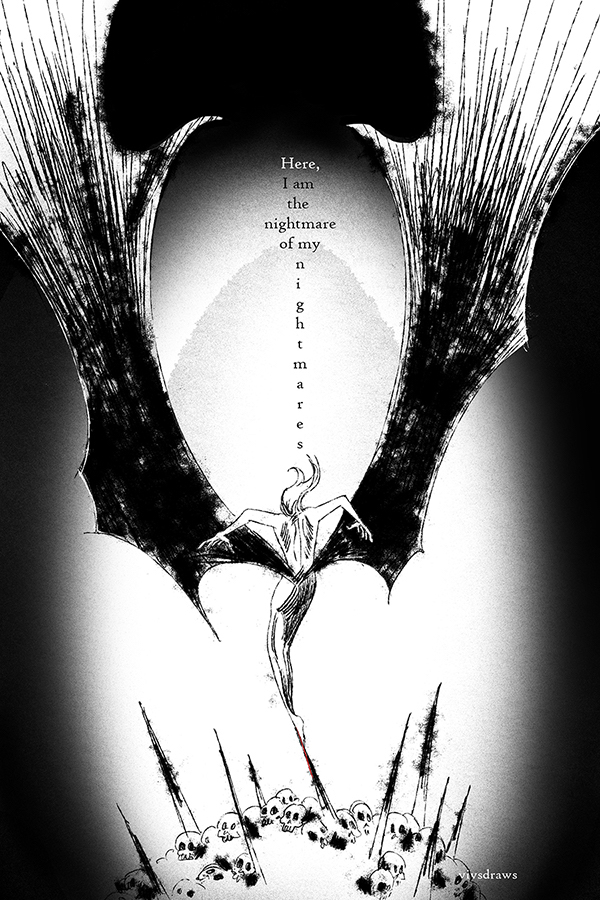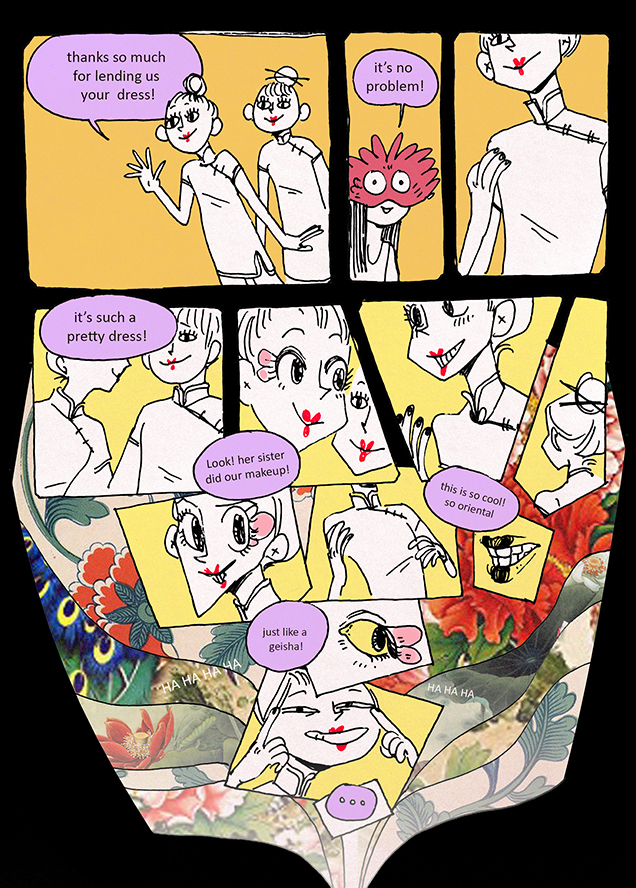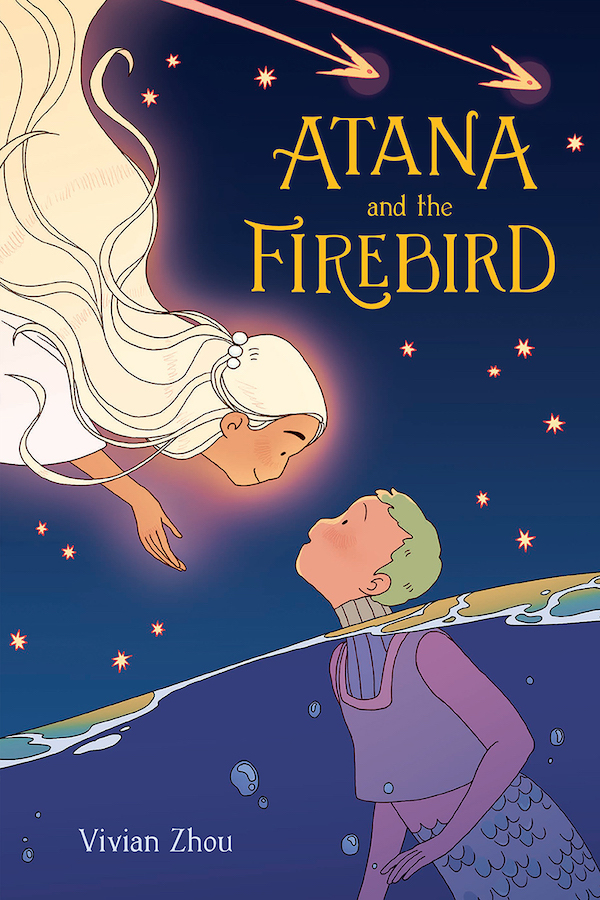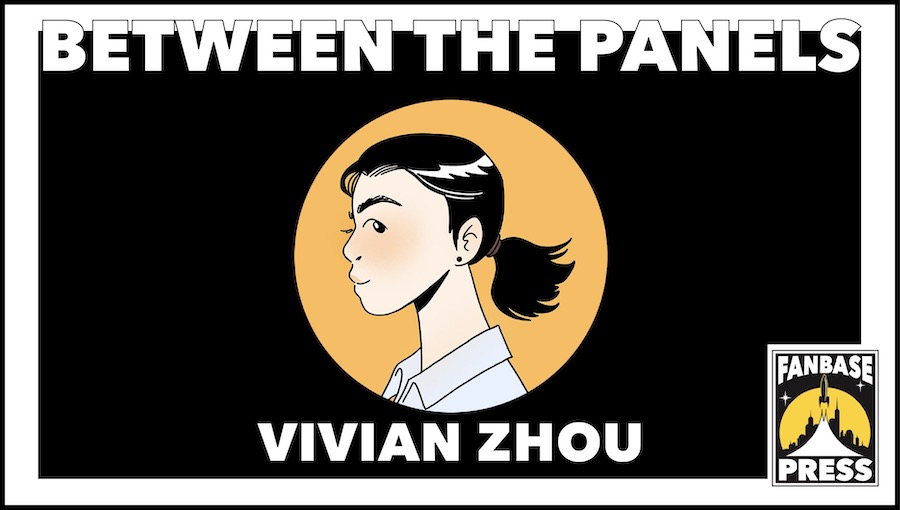“Between the Panels” is a bi-weekly interview series focusing on comic book creators of all experience levels, seeking to examine not just what each individual creates, but how they go about creating it.
In another timeline, Vivian Zhou might have followed her original career path in the field of animation. Instead, she heeded the siren song of comics — and her creative passion — which has led to the imminent arrival of her debut graphic novel, Atana and the Firebird.
First off, the basics…
Your specialties (artist/writer/letterer/inker/etc.): Writer/Artist
Your home base: Nova Scotia
Website: vivianzhou.ca
Social Media
Instagram: @vivsdraws
Twitter: @vivsdraws
Fanbase Press Contributor Kevin Sharp: As a person who’s worked in multiple storytelling disciplines, what does the comics form offer you that’s appealing as a creator and as an artist?
Vivian Zhou: For me, at least, it is a one-person job. So, as long as my editor is on board with whatever it is that I’m doing, I can pretty much just go ahead and do it. Also, for shorter comics, I don’t even have an editor to answer to — I can just make whatever it is that I want, and it just exists. For me, it’s a very low-barrier medium to tell a story; I used to work in animation, and to make an animated short would require a lot more work and time. Comics, I can make whatever, whenever.
KS: I want to start off with a craft question for you as a former animation storyboard artist. Did your past work in that field inform your comics creation process? I think people looking in from the outside consider them similar in the sense that they’re both laying out a visual narrative, but do you find them complementary to each other?
VZ: That’s a really good question. I do think the drawing aspect of storyboards does help. You’re trained in the layout of scenes, and the different kinds of shots and compositions that you can have. Comics are paced very differently from storyboards. When I was first drawing Atana, I would be drawing too many panels because, doing storyboards, it was my instinct to board out every action. But in comics, you have this gap between panels where people can fill it in with their imaginations and you don’t have to draw out absolutely everything that happens. Time flows differently in comics; each panel is a new moment in time. You don’t necessarily have to sync up to the previous panel. That was something I had to find out the hard way.

KS: Let’s jump back to the beginning of your journey. Can you recall when comics first arrived in your life, in whatever format?
VZ: My dad was an avid comics reader, so he had huge collections of Tintin, Snoopy, Garfield — that kind of Western Sunday, four-strip cartoon kind of comics. We had lots of those. I started off by copying those comics, and I think you can still see it in my art style a little bit. When I became a teenager, I got into manga like Sailor Moon, that kind of stuff. [Then] I came to North America and I discovered graphic novels, which was a whole new world of oh, this is a thing that you can do. I read Skim by Mariko and Jillian Tamaki. I didn’t know you could make comics like that. So, that was, yeah, that’s like my comics journey between the different genres, I guess.
KS: When you were first reading those strip collections, could you follow the stories? I know they’re often just setups for jokes, but did the format go beyond being appealing solely on a visual level?
VZ: When you’re a kid reading Calvin and Hobbes, you don’t get the deeper meaning. With Tintin, it was different because those were more action/adventure comics. Now that I’m grown up, I still go back and read Calvin and Hobbes and see things I didn’t appreciate back then.
KS: Talking about the Tamaki book actually teed up my next question, and that is about a comic book story that really resonated with you as a reader. Something that you found at just the right time for who you were then.
VZ: It’s the stories that made me first think that I wanted to do this for a living, which I think is Rumiko Takahashi’s Ranma. I remember when I was a kid, I used to tell my parents that I wanted to be her assistant when I grew up. I didn’t realize that it was possible to do comics for a living until I got to college, so that was a dream that accidentally became true. [laughter]
KS: Can you recall what it was about that series that clicked for you?
VZ: She had an art style that I loved. It’s just a very fun story, and it’s a blend of things that I like. There’s a lot of action. It’s very funny. There are elements of just, like, slice of life — people being silly and forming relationships and that kind of stuff. I also loved copying her books.
KS: What did your creative life look like back then in general? What kinds of things did you enjoy making or dabbling with?
VZ: I think I’m very lucky because my parents always encouraged me to draw. It was a lot of copies of Snoopy and Charlie Brown. I would draw me and my friends in [that] style, a huge head and a tiny body and we all looked the same. [laughter] Also stories from school, or “here’s this girl that I like,” or “here’s this person that I don’t like.” That kind of stuff. Then in high school when I started copying anime, my art became more influenced in that direction. I liked that fact that I drew and sketched a lot.

KS: You mentioned that your parents encouraged your hobby, but what about when it came to turning that into a potential career? Was the family support still there?
VZ: Yeah, I was very lucky. In the last couple years of high school, I’d had enough of doing math questions and studying psychology. I decided I was going to art school and my parents were like, “Yeah, okay.” It was very straightforward for me.
KS: How about choosing a school?
VZ: I went to study animation. I thought if I was going to start studying art, I should have at least a semi-stable industry, right? And I love animation. So, I basically just googled “animation schools.” [laughter] The first one that came up was Sheridan [College]. I read the Wikipedia page and said, “That’s the one.”
KS: Since animation was your first official discipline, I have to put you on the spot: favorite animated movie?
VZ: Definitely Castle in the Sky. That one makes me so happy whenever I watch it.
KS: When you arrived at Sheridan and were focused on this major, did you have a vision of what your life would look like after graduation?
VZ: I focused on storyboarding and that’s what I thought I’d keep doing after graduation. I did work in a studio for a bit as a storyboard artist. It was unexpected when I made a career change. I thought that I’d do comics for a year and then I’d go back to animation, but it didn’t happen that way. It’s not the way I planned it, but I’m not mad at how it turned out.
KS: On the topic of that career change, what lit the fire under you to want to do comics at all?
VZ: After being in a studio, working on client projects, I really wanted to have a big project I could present and say, “This is mine. This is the story I wanted to make, and I made it.” It was very selfish — I wanted creative control. I happened to get a grant around that time that allowed me to sustain myself for a bit. I was like, “okay, I’m gonna take this leap of faith and see where this goes.”
KS: For readers who may not be familiar with all of your work, talk a little about the project you set out to make while you had that grant as a safety net.
VZ: That project was Atana and the Firebird, which is my debut graphic novel. I originally pitched it as a webcomic, but once I actually got started, I realized it was on a scale that I’d maybe not be able to handle on my own, especially if I wanted to print it. I didn’t want to deal with logistics and all of that, and I was very lucky that my agent found me around that time, too. She found me through Twitter, and then we decided to pitch the story to different publishers. It was like three months where everything just kind of all fell together, and then, suddenly, I had a publishing deal. I don’t know how it happened.
KS: Aside from Atana, you’ve done some webcomics and also had shorts appear in anthologies. Were you doing all of that while simultaneously working on your big, longform project?
VZ: In college, I started drawing some diary comics of stupid stuff that would happen between me and my friends. If somebody made a really bad joke, I might draw a comic about it. I also started developing Atana, but that was just sort of a nebulous idea in the back of my head. After I graduated college, I made a couple short comics that did really well online. It really shocked me that a simple story that might be very personal to me also might resonate with so many people, so many strangers on the internet. It really encouraged me to make more short stories, and I love short comics for that reason, because you can experiment a lot with the story that you’re telling, the way that you’re drawing it, or even what medium you’re drawing it in.

KS: How were you getting that feedback to know you were reaching people with your work?
VZ: People would leave comments on Twitter. Sometimes, people were bringing up things that I didn’t think of when I was drawing the comic and I was like, whoa, that’s neat that you got that from it. I did one short horror story that people left a bunch of different theories [on]. I’m not gonna say if any were correct or not, but it was just really fun to read all these theories!
KS: Can you talk about your creative process for making short comics? Do you start with a story you want to tell, or do you find your way in through just doodling images and let the story build out from there?
VZ: If I don’t have a story in my head already, I don’t know what the characters will look like, what they do, where they live. So, I have to have a pretty solid idea before I start drawing. Also because I’m lazy, it’s a lot easier to just, you know, sit here and daydream. [laughter]
KS: To go into Atana specifically, what was the early seed of an idea — or ideas — that grew up into the book?
VZ: This is the one exception where I drew the character first and went from there. I designed Atana, and then thought it would be cool if she had a friend who was a star. So, that’s where the Firebird came in. Everything grew from there. In the beginning, it was just a mermaid and her friend who was a star.
KS: Over the years you were developing this, would you keep notes? How do you keep the thing alive kind of in your mind throughout a long creation process?
VZ: I have a lot of sketchbooks with different variations of all these characters. I think Atana didn’t change that much, but everybody else changed a lot. The story changed a lot. It was kind of fun to think about this world in little bursts at first, because I didn’t have the pressure to make it a real book. It was just a fun thing for me to imagine… What’s this world like? What could the characters be struggling with? What’s bothering them? All of that, I think, helped to kind of snowball into a bigger story.
KS: Let’s do a couple of hypotheticals before we wrap up. First, you get to spend one day in the studio of any artist from the history of comics. You can sharpen pencils for them, ask questions, get them coffee, watch them work. Who are you hanging out with?
VZ: I think he would hate it, but… Bill Watterson. [laughter] He’s so good at what he does; I’d want to be a fly on the wall and just watch. Preferably one of his Calvin and Hobbes watercolors. I’d want to see what materials he’s using — what inks, what brushes. How he’s agonizing over the ideas. I just want to know.
KS: Next, imagine a Comics Hall of Fame and you get to induct one title. What would be the book that you’d say represents this medium at its absolute best, it belongs in the Hall of Fame, and here’s your name on the plaque underneath it as the sponsor?
VZ: Such a stressful question! I guess Maus. There’s nothing else like it. Certainly because of the subject first, but it’s such an important piece of work in that it recounts this bit of history in a very personal, very sharp way, if that makes sense. Because it’s a graphic novel, it’s accessible in a way that maybe a [regular] book on the same subject wouldn’t be. Also, I think it’s like on, also on the accessibility front, it’s, I don’t know what audience it’s intended for, but certainly a younger audience can also read it and get a very strong reaction. I think the same is true for Persepolis. The graphic novel is a really, really powerful way of telling these kinds of stories.

KS: And to close out, please let readers know when and where to look for Atana.
VZ: Atana and the Firebird is my first graphic novel, coming out November 7. It’s about a little mermaid who is friends with a firebird, and they go on a magical adventure together. It’s a combination of everything that I liked reading about as a kid and it’s available anywhere books are sold.

